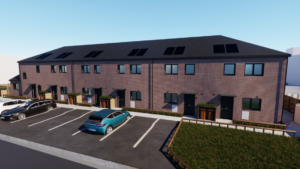Is Sheffield about to experience a cohousing revolution?
 Cohousing developments, for those unfamiliar with the term, consist of individual dwellings grouped around shared facilities and spaces, and run by their residents. The concept, initially developed in Denmark in the 1960s, is becoming increasingly attractive in the UK, particularly among older people and young families, where the increased support and interaction between neighbours can have many benefits.
Cohousing developments, for those unfamiliar with the term, consist of individual dwellings grouped around shared facilities and spaces, and run by their residents. The concept, initially developed in Denmark in the 1960s, is becoming increasingly attractive in the UK, particularly among older people and young families, where the increased support and interaction between neighbours can have many benefits.
There are numerous challenges for the would-be co-houser however, from finding land or buildings and groups of like-minded people, through to building, financing and developing the project. On top of this, regular meetings, often after a busy day at work, and the group decision-making process can take its toll. Nonetheless a number of successful cohousing schemes now exist in the UK, from the Springhill project in Stroud, to Lilac in Leeds and Lancaster Cohousing.
In Sheffield, the Sheffield Cohousing Network (SCN) has been established by a number of individuals, some with previous experience of co-operative living models, to share information and establish cohousing projects in the city. The network contains a mixture of emerging and established groups, as well as numerous interested individuals.
The city council and the University’s School of Architecture are now coming together
around housing issues, and facilitating different ways of living more collectively.
The demographic of the network, or its core members in any case, is well-informed and often over 60, and many of these individuals are able to sell their existing houses to finance new developments. There is, however, a strong desire to live in communities that are mixed both in terms of age and income, and the SCN is exploring how working with local housing associations, and using different procurement models might help, and this is where things get interesting.
Both the city council and the University’s School of Architecture are now coming together around issues of housing, and facilitating different ways of living more collectively.
The School of Architecture has been investigating how it can help groups such as the Sheffield Cohousing Network through making relevant research, usually out of reach of the general public, available, and linking student projects to real groups, a situation that benefits both parties. A recent example of this was the Motivating Collective Custom Build research project, led by a team from the University of Sheffield’s School of Architecture, in collaboration with architects Ash Sakula and Design for Homes.
Sheffield Council’s housing team are also freeing up sites across the city for housing, in particular for custom build (i.e. not speculative but end-user led), signing up to become one of the UK’s vanguard councils in testing a Right to Build policy and facilitating end-user led development.
SCN’s meetings with the council have led to a number of possible outcomes, one of which being the possibility of cohousing groups working directly with the Sheffield Housing Company (a development partnership) to influence design and specification of new housing schemes.
This autumn School of Architecture’s pioneering Live Projects (in which groups of Masters students work with real clients) will be working with Sheffield Council and the Cohousing Network to explore how an initial 12 sites might be developed for housing, and what the potential issues and opportunities might be.
It is interesting to note however, that the majority of sites earmarked for custom build by Sheffield Council are in the most deprived areas of the city. The key challenge remains how to inform and empower a greater number of those who do not have the time, funds and knowledge to find out about or engage in cohousing, or collective forms of living, yet maybe have most to gain from them.
Universities can have a crucial role here in informing both the public at large and local government, providing strategic guidance that is immediately accessible. Design professionals such as architects can provide a key role in facilitating and guiding groups at early stages – experience in Germany in particular has borne this out.
Watch this space.
















Thank you for the article Mark. Interesting stuff. The disposable wealth and equity capital will produce a powerful impetus for this kind of new community. Where would one look in the UK for examples of best practice? My wife and I have just downsized into a mews style refurbishment in South Sheffield and the developer created a type of central green space that has the feel of a shared amenity that has, in turn, created a strong sense of neighbourliness.